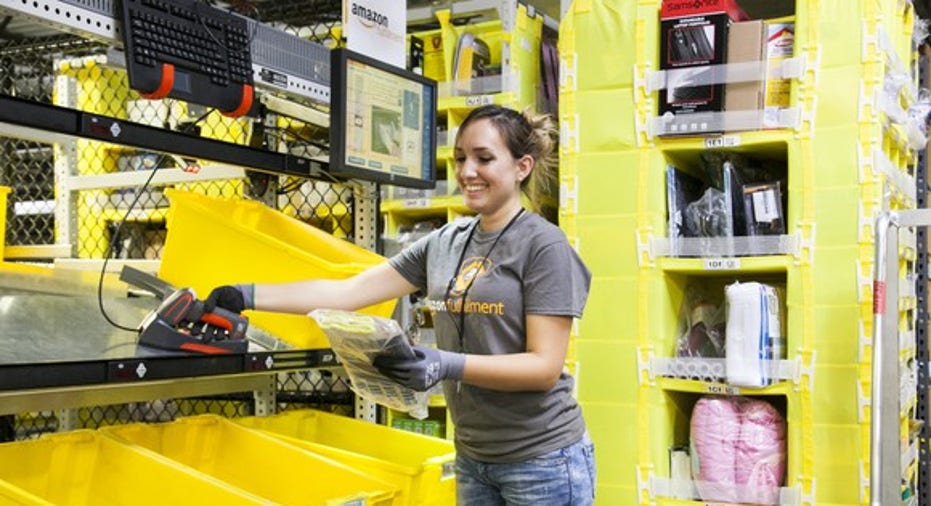There's a 44% Chance You Live Near an Amazon Fulfillment Center

Image source: Amazon.com.
It's no secret that brick-and-mortar retailers are feeling the pressure as more shoppers choose to purchase goods online. And in the past few years, Amazon.com (NASDAQ: AMZN), the leading online retailer, has made it easier and easier for consumers to get everything they need without leaving the comfort of their couch.
Piper Jaffray analyst Gene Munster estimates that 44% of the U.S. population now lives near an Amazon warehouse or delivery station. He goes on to suggest that with a delivery network so large, one-hour or same-day delivery -- a perk available to Prime members -- could functionally replace everyday trips to the store.
That's bad news for Wal-Mart (NYSE: WMT) and Target (NYSE: TGT), which have both struggled to grow revenue in recent years.
Spending the competition out of business
Over the past four years, Munster estimates that Amazon's fulfillment center penetration has grown from about 7% in 2012 to 44% today. Building out all those facilities isn't cheap, and it's evident in Amazon's fulfillment costs.
Through the first half of 2016, the company's fulfillment costs grew 34%. That's slightly faster than total revenue, which grew nearly 30% over the same period. From 2012 through 2015, fulfillment expenses grew 109%.
Granted, not all of that goes toward building out fulfillment centers. As Amazon revenue grows, its fulfillment costs naturally increase, since there are more orders to ship. But Amazon says "Fulfillment costs primarily consist of those costs incurred in operating and staffing our North America and International fulfillment and customer service centers and payment processing costs." For the second quarter of 2016, management cites "costs from expanding fulfillment capacity" specifically as a reason fulfillment costs grew.
The impact can also be seen in Amazon's capital expenditures. Capex grew 38% through the first half of the year, and the growth primarily represents "additional capacity to support our fulfillment operations," as well as investments to support the growth of AWS -- Amazon's cloud computing business.
More expansion coming
Management expects to increase fulfillment costs even more in the third quarter as it opens 18 new locations. For reference, the company opened a total of 10 fulfillment centers through the first three quarters of 2015 combined.
Amazon is expecting a big fourth quarter, fueled primarily by its Fulfillment by Amazon program. During the company's second quarter earnings call, CFO Brian Olsavsky noted that FBA unit shipments are growing faster than those that Amazon sells directly. What's more, total unit sales accelerated year-over-year from 22% to 28% growth.
With that in mind, the company needs to ensure that it has the capacity to deliver all of the orders that come in during the holiday season. Last year, Amazon found itself capacity constrained in the fourth quarter, which resulted in unnecessary fulfillment costs.
So while the company expects operating margins to take a hit in the third quarter from the increased expense, the fourth quarter should show improved margins.
The impact on Wal-Mart and Target
Leading big box stores have clearly seen the impact from Amazon and other online retailer's sales growth over the past few years. Wal-Mart, for example. saw its total revenue increase just 0.5% last quarter.
But the company has been able to sustain modest U.S. foot traffic increases between 1% and 2% over the past few years. Target, on the other hand, saw its U.S. foot traffic decline 2.2% last quarter after enjoying similar growth.
That is to say Wal-Mart has done a decent job defending against Amazon's expansion so far, but Target may be starting to feel the pressure. Wal-Mart has also taken steps to combat Amazon's Prime Now service, which offers two-hour delivery in select regions, by rapidly expanding its online grocery ordering to new markets.
But Prime Now is still in its early stages. Amazon counts 40 metro areas served by Prime Now. Additionally, 27 areas have access to same-day shipping(Prime Now only offers a subset of what's available on Amazon, while nearly everything's available for same-day shipping markets). As Amazon grows its fulfillment center network, we should see Prime Now markets expand to cover more of the country as well.
While 44% is still small reach compared with Wal-Mart and Target, Munster believes Amazon could eventually reach 70% to 80% of the population, which should prove to have an even bigger impact on traditional retailers.
A secret billion-dollar stock opportunity The world's biggest tech company forgot to show you something, but a few Wall Street analysts and the Fool didn't miss a beat: There's a small company that's powering their brand-new gadgets and the coming revolution in technology. And we think its stock price has nearly unlimited room to run for early in-the-know investors! To be one of them, just click here.
Adam Levy owns shares of Amazon.com. The Motley Fool owns shares of and recommends Amazon.com. Try any of our Foolish newsletter services free for 30 days. We Fools may not all hold the same opinions, but we all believe that considering a diverse range of insights makes us better investors. The Motley Fool has a disclosure policy.